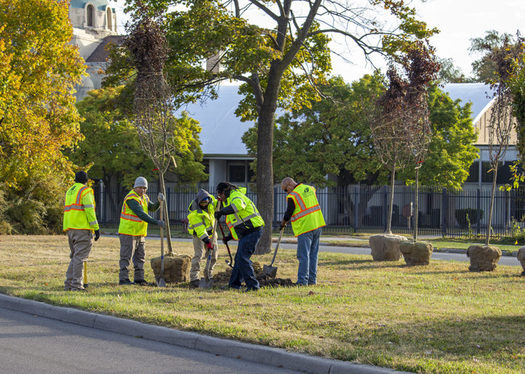Notifications
-
1.9K Views 0 Comments 0 Likes 0 Reviews

By Kate Wheeling for Nexus Media News.
Broadcast version by Suzanne Potter for California News Service reporting for the Solutions Journalism Network-Public News Service Collaboration
After a series of winter storms pummeled California this winter, thousands of trees across the state lost their grip on the earth and crashed into power lines, homes, and highways. Sacramento alone lost more than 1,000 trees in less than a week. Stressed by years of drought, pests, and extreme weather, urban trees are in trouble.
The U.S. Forest Service estimates that cities are losing some 36 million trees every year, wiped out by development, disease, and, increasingly, climate stressors like drought. In a recent study published in Nature, researchers found that more than half of urban trees in 164 cities worldwide were already experiencing temperature and precipitation conditions beyond their survival limits.
"So many of the trees that we've relied upon heavily are falling out of favor now as the climate changes," said Nathan Slack, the urban forest superintendent for the city of Santa Barbara. He noted that conifers, like pines and coastal redwoods, once extensively planted along the coast, are dying in droves. "The intensity of heat [and] the longer periods [without] rainfall force us, as urban forestry managers, to reimagine what are good street trees."
Trees help keep neighborhoods cool, absorb rainwater, and reduce. But to provide those critical functions, they must survive those conditions. For many cities, that means reconsidering what species are planted.
Slack said he is looking to trees that typically grow further east, like the paloverde, that does better in warmer, drier conditions. "The trees that survive in the desert are going to be much more useful to us here," he said.
In Sacramento, species like the "Bubba" desert willow are replacing redwoods, said Jessica Sanders, the executive director of the Sacramento Tree Foundation. "It's sad because it's an iconic tree," Sanders said, "but it's not suited to the Sacramento region's climate at this point."
It's not just California cities that are rethinking their canopies.
In Harrisonburg, Virginia, officials are bringing willow oak and sweetgum - trees more tolerant to heat than many local species - from the coast. In Seattle, they're planting more Pacific madrone and Garry oaks, which stand a better chance of surviving hotter, drier summers.
In Detroit, once known as the "City of Trees" for its extensive canopy, officials are planting hardy trees like the Eastern redbud, American witch hazel, and White oak that can withstand extreme heat and flooding.
City officials are also expanding species diversity to fend off disease, aiming only to allow a single species to comprise up to 10% of the city's canopy. Detroit lost much of its canopy between the 1950s and 1990s to Dutch elm disease and an emerald ash borer, an invasive beetle. Today almost 40% of the remaining trees are considered "poor quality," said Jenni Shockling, the senior manager of urban forestry in Detroit for American Forests, a nonprofit. "[They] consist of species prone to disease and storm damage, cause property and infrastructure damage, and drop heavy amounts of debris."
Preserving urban tree cover can mean the difference between life and death on a heating planet. It kills roughly 12,000 people annually in the United States; experts say that figure could reach 100,000 by the century's end. However, a by the Lancet in January found that a 30% increase in a city's tree cover could cut heat-related deaths by a third.
Poorer neighborhoods with large non-white populations tend to have less tree cover and can get up to 20 degrees warmer than wealthier (and greener) areas, according to several studies. "A map of trees in any city in America is a map of income and race," said Jad Daley, the president, and CEO of the nonprofit American Forests.
Cites may soon see some relief. The Inflation Reduction Act, signed into law last year, includes $1.5 billion for the Forest Service's Urban and Community Forestry Program, amounting to a five-fold increase in the program's annual budget.
According to experts like Daley, the funding can potentially transform urban canopies. But as Slack and other arborists across the country turn to new species to fill their streets, they're running into a new issue: supply.
"Right now, there are bottlenecks in the traditional nursery supply line," said Shockling. "Growers tend to favor specific species because they grow well in the nursery or proliferate, but that doesn't necessarily speak to the species diversity standards we're trying to adhere to."
American Forests has partnered with the U.S. Forest Service to invest in and develop nurseries nationwide to improve the supply chain. "The nurseries need some assurances that what they're growing is going to have market value, and we have the assurance that what we're going to purchase will have a supply," Shockling said.
According to David Teuschler, the chief horticulturist at Devil Mountain, one of California's largest nurseries, those large-scale investments will be crucial to updating the make-up of urban canopies.
According to Teuschler, even California native trees, like the Coastal Live oak, struggle in the state's droughts. He'd like to invest more in trees like Mesa oak or Silver oak to sell in Northern California, Swamp mallet, or Salt Marsh gum in Southern California. Still, it can take years to grow trees to a saleable size, and then he has only a limited time to sell those seedlings. Unsold trees are usually composted, burned, or otherwise destroyed.
He needs to know he'll have customers with a clear eye toward the future.
"You have to remember that many old-school people out there want to plant redwoods," he said. "You want to be the nursery with these drought-adapted species, but if you can't sell them, it's waste."
One of Devil Mountain's longtime customers is California arborist Dave Muffly, who stocks all his projects with drought-tolerant species.
Muffly began looking for drought-resistant trees 15 years ago while leading a project to plant 1,000 trees along a two-mile stretch of highway through East Palo Alto. He wanted evergreens to block freeway pollution from reaching the low-income community on the other side and drought-tolerant varieties, but most of the state's nurseries held few options.
Muffly began scouring the Southwest for acorns from hardier species of oaks; with more than 500 species of oak around the world that can breed and create viable hybrids, the trees are particularly likely to evolve traits that can help them survive rapid climate change; Muffly said.
With Teuschler's help, his projects - including a 9,000-tree mega-project around Apple's campus - have served as a proof of concept for cities as they work toward climate-resilient tree canopies.
Through channeling federal funding toward nurseries like Devil Mountain, this kind of holistic system could be replicated around the country to meet each region's unique needs, Muffly said.
"The truth is we don't grow anywhere near enough trees in the United States to spend the money that the government just put out," Muffly said. "So now it's time to build an arsenal of ecology, and the production lines are the new nurseries that will have to be built to grow the trees."
Kate Wheeling wrote this article for Nexus Media News.


Share this page with your family and friends.